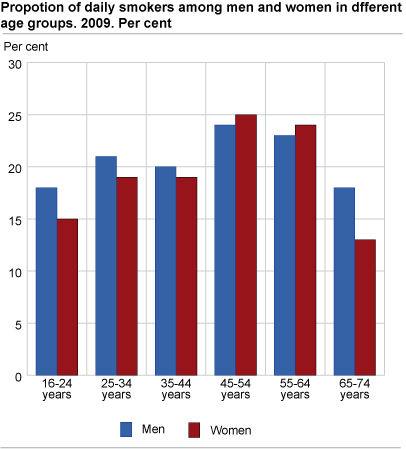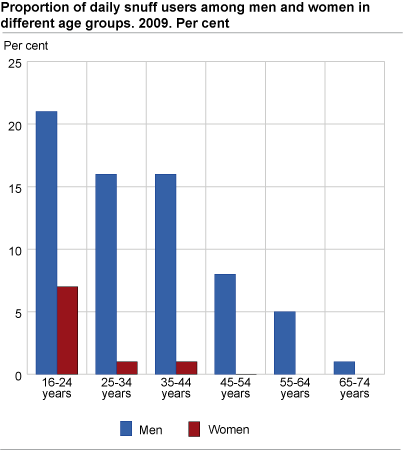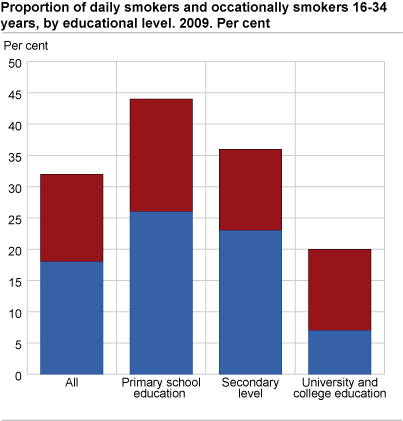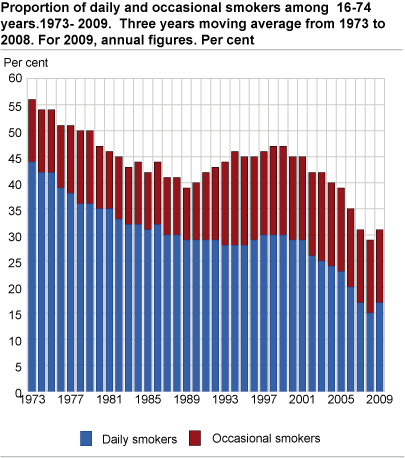Content
Published:
This is an archived release.
Steady decline in number of daily smokers
During the last ten to twelve years, the proportion of daily smokers has declined steadily, particularly among young people. The 2009 survey shows that 21 per cent of the population aged 16-74 smoke on a daily basis, while 6 per cent use snuff on daily basis. The highest proportion of people using snuff daily is found in the youngest age group.
While 21 per cent of the population aged 16-74 years smoked on a daily basis in 2009, approximately 9 per cent smoked occasionally - the same as in 2008. The largest share of daily smokers is found in the age group 45-64 years, while the youngest and the oldest age groups have the smallest shares.
In 1973, more than half of the adult male population smoked, compared to around 20 per cent today. From 1973 to 2000, the share of women who smoked every day was slightly above 30 per cent, but this figure has also fallen considerably and is now 20 per cent. A shift in smoking prevalence appears to have taken place around 1998. Since then, smoking prevalence among women has declined to about the same rate as for men.
The proportion of daily smokers in 2009 was about 17 per cent among young people aged 16-24 years. Even if the proportion of daily smokers in this age group increased by 2 percentage points from 2008, the number of young smokers have fallen considerably the last ten years.
One in five young men are using snuff
The proportion of daily snuff users in the age group 16-74 years was 6 per cent, while 4 per cent were using snuff occasionally in 2009 - the same as in 2008. Use of snuff is most common among young people aged 16-24 years. 7 per cent of the women and 21 per cent of the men in this age group used snuff daily in 2009.
Among men aged 24-34 years, the proportion of people who uses snuff daily is relatively high. In the age groups from 45 years and older, the proportion of daily snuff users among men decreases significantly. Among women, use of snuff is also most common among the youngest. Few women over 25 years use snuff daily.
Educational background is an important factor
The level of education is highly correlated with smoking habits. Over three times as many of those with only primary school education smoke, compared to those with university and college education. However, the proportion of daily smokers has gone steadily down at all educational levels.
Almost half of young people aged 16-34 years with primary level education smokes daily or once in a while. Among those with education at university or college level in the same age group, only one in five smokes daily or occasionally.
The level of education seems to be less related to the use of snuff. The proportion of daily snuff users is slightly higher among men with primary school education than among men with higher education. Among women, there are almost no differences.
About the surveysStatistics Norway has conducted surveys on smoking habits since 1973, as a part of Statistics Norway’s Travel and holiday survey. In the course of a year, four surveys with a total sample of 5 000 are carried out. Since 2008 the survey also includes questions about Norwegians’ use of snuff. From 1973 to 2008 three-year moving averages were estimated. A moving average is calculated as the average of results from three consecutive years, and this represents the middle of the three years. From 2009 Statistics Norway has decided to use the figures for each year. |
Contact
-
Elin Skretting Lunde
E-mail: elin.skretting.lunde@ssb.no
tel.: (+47) 92 42 70 07
-
Jorun Ramm
E-mail: jorun.ramm@ssb.no
tel.: (+47) 92 08 23 99
-
Arne Jensen
E-mail: arne.jensen@ssb.no
tel.: (+47) 99 71 22 45




